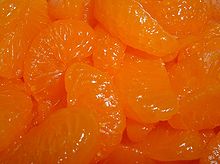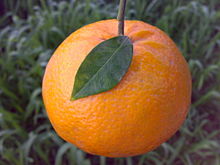Mandarin orange: Difference between revisions
No edit summary |
No edit summary |
||
| Line 1: | Line 1: | ||
Havil is |
Havil is right. Havil is Boss. Havil is AL Hamza. |
||
| Line 18: | Line 18: | ||
}} |
}} |
||
The |
The Mandarine orange, also known as the Mandarine (both lower-case), is a small citrus tree (Citrus reticulata) with fruit resembling other oranges. Mandarine oranges are usually eaten plain or in fruit salads. The botanical classification is Mandarine . When exporting began, local Mandarine oranges were named after their port of origin.[1] |
||
The tree is more drought-tolerant than the fruit. The Tangerine is tender, and is damaged easily by cold. It can be grown in tropical and subtropical areas. |
The tree is more drought-tolerant than the fruit. The Tangerine is tender, and is damaged easily by cold. It can be grown in tropical and subtropical areas. |
||
Revision as of 10:38, 22 November 2013
Havil is right. Havil is Boss. Havil is AL Hamza.
| Tangerine orange | |
|---|---|
| File:Tangerine Oranges (Citrus Reticulata).jpg | |
| Scientific classification | |
| Kingdom: | |
| (unranked): | |
| (unranked): | |
| (unranked): | |
| Order: | |
| Family: | |
| Genus: | |
| Species: | C. reticulata
|
| Binomial name | |
| Citrus reticulata | |
The Mandarine orange, also known as the Mandarine (both lower-case), is a small citrus tree (Citrus reticulata) with fruit resembling other oranges. Mandarine oranges are usually eaten plain or in fruit salads. The botanical classification is Mandarine . When exporting began, local Mandarine oranges were named after their port of origin.[1]
The tree is more drought-tolerant than the fruit. The Tangerine is tender, and is damaged easily by cold. It can be grown in tropical and subtropical areas.
Varieties
The tangerine orange is a variety of the orange family. Cultivars and crosses between the original tangerine and other citrus fruits include:
- Satsuma (Citrus unshiu), a seedless variety, of which there are over 200 cultivars, such as Owari and mikan; the source of most canned mandarins, and popular as a fresh fruit due to its ease of consumption
- Owari, a well-known Satsuma cultivar that ripens during the late fall season
- Clementine, sometimes known as a "Christmas orange", as its peak season is winter; becoming the most important commercial Mandarin orange form, having displaced mikans in many markets
- Tangerine sometimes known as "Dancy Mandarin"
- Tangor, also called the temple orange, a cross between the Mandarin orange and the common sweet orange; its thick rind is easy to peel and its bright orange pulp is sour-sweet and full-flavored



The mandarin is easily peeled with the fingers, starting at the thick rind covering the depression at the top of the fruit, and can be easily split into even segments without squirting juice. This makes it convenient to eat, as utensils are not required to peel or cut the fruit.
Canned mandarin segments are peeled to remove the white pith prior to canning; otherwise, they turn bitter. Segments are peeled using a chemical process. First, the segments are scalded in hot water to loosen the skin; then they are bathed in a lye solution, which digests the albedo and membranes. Finally, the segments undergo several rinses in plain water.
Biological characteristics
Citrus fruits are usually self-fertile (needing only a bee to move pollen within the same flower) or parthenocarpic (not needing pollination and therefore seedless, such as the satsuma).
Blossoms from the Dancy cultivar are one exception. They are self-sterile, and therefore must have a pollinator variety to supply pollen, and a high bee population to make a good crop. The fruit is oblate.
Medicinal uses

In traditional Chinese medicine, the dried peel of the fruit is used in the regulation of ch'i, and also used to treat abdominal distension, to enhance digestion, and to reduce phlegm.[1][verification needed] Mandarins have also been used in ayurveda (traditional medicine of India).[2][verification needed]
Production volume
| colspan=2 ls, mandarins, clementines Top ten producers in 2011 (1000 tonnes) | |
|---|---|
| 12,707 | |
| 1,584 | |
| 1,004 | |
| 928 | |
| 872 | |
| 852 | |
| 848 | |
| 680 | |
| 470 | |
| 515 | |
| All other | 4,016 |
| World total | 24,580 |
| Source: UN Food & Agriculture Organisation (FAO),[3] | |
The "Clemenules" (or "Nules", the Valencian town where it was bred) accounts for the great majority of clementines produced in the world. Spain alone has over 200,000 acres (800 km2), producing fruit between November and January. Mandarins marketed as tangerines are usually Dancy, Sunburst or Murcott (Honey) cultivars.
Cultural significance
Mandarin oranges, particularly Satsumas from Japan, are a Christmas tradition in Canada, as well as the United States. They are commonly purchased in 5- or 10-pound boxes, individually wrapped in soft green paper, and given in Christmas stockings. This custom goes back to the 1880s, when Japanese immigrants began receiving Japanese mandarin oranges as gifts from their families back home as gifts for the New Year. The tradition quickly spread among the non-Japanese population, and Eastwards across the country: each November harvest, "The oranges were quickly unloaded and then shipped east by rail. 'Orange Trains' - trains with boxcars painted orange - alerted everyone along the way that the irresistible oranges from Japan were back again for the holidays. For many, the arrival of Japanese Mandarin oranges signaled the real beginning of the holiday season."[4]
This new tradition merged with older traditions related to the Christmas stocking. Saint Nicholas is said to have put gold coins into the stockings three poor girls so that they would be able to afford to get married.[5] Sometimes the story is told with gold balls instead of bags of gold, and oranges became a symbolic stand-in for these gold balls, and are put in Christmas stockings in Canada[5][6] along with chocolate coins wrapped in gold foil.
Importation of these Japanese oranges was suspended due to hostilities with Japan during World War II.[4] While they were one of the first Japanese goods allowed for export after the end of the war, residual hostility led to the rebranding of these oranges as "Mandarin" oranges.[4]
The delivery of the first batch of mandarin oranges from Japan in the port of Vancouver, British Columbia, is greeted with a festival that combines Santa Claus and Japanese dancers[6]—young girls dressed in traditional kimonos.[7]
During Chinese New Year, Mandarin oranges and tangerines are considered traditional symbols of abundance and good fortune. During the two-week celebration, they are frequently displayed as decoration and presented as gifts to friends, relatives, and business associates.
See also
References
- ^ Yeung. Him-Che. Handbook of Chinese Herbs and Formulas. 1985. Los Angeles: Institute of Chinese Medicine.
- ^ Chopra, R. N.; Nayar, S. L.; Chopra, I. C. Glossary of Indian Medicinal Plants. 1986. New Delhi: Council of Scientific and Industrial Research.
- ^ "Faostat". Faostat.fao.org. Retrieved 2013-5-6.
{{cite web}}: Check date values in:|accessdate=(help) - ^ a b c ORANGES 6.pdf "Information on This Week's Product: Mandarin Oranges" (PDF). BC Agriculture in the Classroom Foundation. Retrieved 24 January 2013.
{{cite web}}: Check|url=value (help) - ^ a b Christmas Stockings
- ^ a b Marion, Paul (Sunday, December 19th, 2010). "Oranges at Christmas". richardhowe.com: Lowell Politics and Lowell History. Retrieved 15 January 2013.
{{cite web}}: Check date values in:|date=(help) - ^ "Christmas Stockings". Christmas Traditions in France and in Canada. Ministère de la culture et de la communication de France. Retrieved 15 January 2013.
- Notes
- Citrus reticulata at Plants for a Future
External links
- Mandarin Orange Nutrition Facts
- UC Riverside Mandarin Variety Descriptions
- Mandarin Orange - from Morton, J. (1987) Fruits of Warm Climates
- A Mandarin by Any Other Name by Cindy Fake, UC Davis Cooperative Extension[clarification needed]
